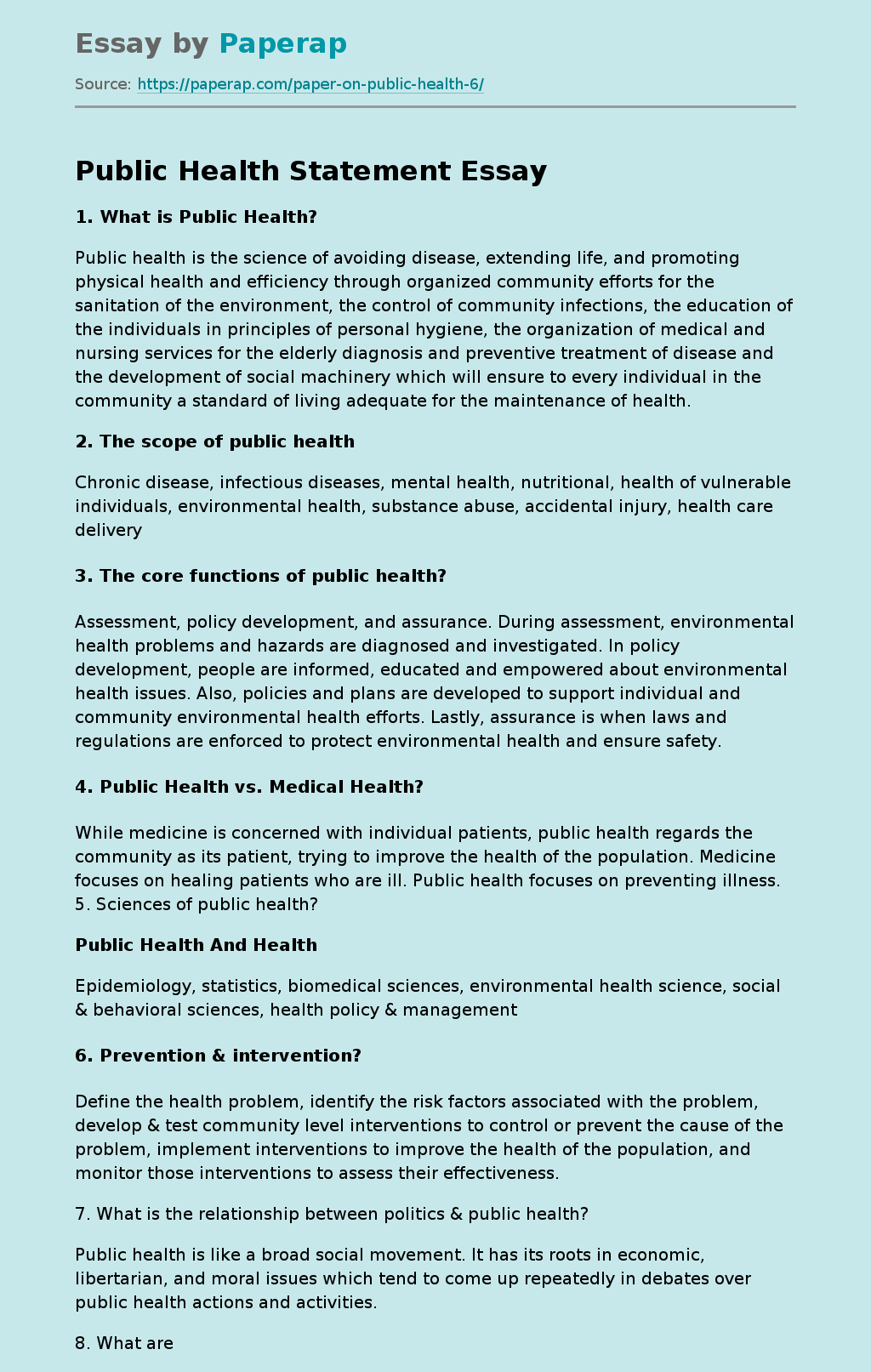Public Health Statement
1. What is Public Health?
Public health is the science of avoiding disease, extending life, and promoting physical health and efficiency through organized community efforts for the sanitation of the environment, the control of community infections, the education of the individuals in principles of personal hygiene, the organization of medical and nursing services for the elderly diagnosis and preventive treatment of disease and the development of social machinery which will ensure to every individual in the community a standard of living adequate for the maintenance of health.
2. The scope of public health
Chronic disease, infectious diseases, mental health, nutritional, health of vulnerable individuals, environmental health, substance abuse, accidental injury, health care delivery
3. The core functions of public health?
Assessment, policy development, and assurance. During assessment, environmental health problems and hazards are diagnosed and investigated. In policy development, people are informed, educated and empowered about environmental health issues. Also, policies and plans are developed to support individual and community environmental health efforts. Lastly, assurance is when laws and regulations are enforced to protect environmental health and ensure safety.
4. Public Health vs. Medical Health?
While medicine is concerned with individual patients, public health regards the community as its patient, trying to improve the health of the population. Medicine focuses on healing patients who are ill. Public health focuses on preventing illness. 5. Sciences of public health?
Public Health And Health
Epidemiology, statistics, biomedical sciences, environmental health science, social & behavioral sciences, health policy & management
6. Prevention & intervention?
Define the health problem, identify the risk factors associated with the problem, develop & test community level interventions to control or prevent the cause of the problem, implement interventions to improve the health of the population, and monitor those interventions to assess their effectiveness.
7. What is the relationship between politics & public health?
Public health is like a broad social movement. It has its roots in economic, libertarian, and moral issues which tend to come up repeatedly in debates over public health actions and activities.
8. What are the 20th century’s top 10 achievements in public health?
Vaccination, motor vehicle, safer workplaces, control of infectious diseases, decline in deaths from coronary heart disease and stroke, safer and healthier foods, healthier mothers and babies, family planning, fluoridation of drinking water, and recognition of tobacco as a health hazard.
9. What are the major challenges for the 21st century in public health?
Poor diet/ exercise, environmental health, tobacco use, substance abuse, mental health, unsafe sex, aging, emerging infections, and access to health care.
10. Measure your BMI & estimate how much exercise you do regularly.?
Calculated BMI: 17. 7 – Average amount of exercise: 1 hour per day
11. What % of the US national budget is spent on PH?
69%
12. Describe some actions that governments have taken to ensure that people are safer and healthier today than people were 100 years ago
Cleaner water, air, food, safe disposal of sewage, and better nutrition.
13. Identify a health problem in your community?
Cancer
14. What are some risk factors associated with the problem?
Family history of cancer, alcohol, poor diet, lack of physical activity, certain chemicals and other substances… etc.
15. Suggest a possible intervention that the community might take to ameliorate the problem.
Staying away from radiation as much as possible, in-taking certain foods such as those rich in beta carotene and other chemical components which may decrease the risk of getting cancer.
References:
- Hobson, J. Allan. “A manual of standardized terminology, techniques and scoring system for sleep stages of human subjects: A. Rechtschaffen and A. Kales (Editors).(Public Health Service, US Government Printing Office, Washington, DC, 1968, 58 p., $4.00).” Electroencephalography and clinical neurophysiology 26.6 (1969): 644.
- Pate, Russell R., et al. “Physical activity and public health: a recommendation from the Centers for Disease Control and Prevention and the American College of Sports Medicine.” Jama 273.5 (1995): 402-407.
Public Health Statement. (2019, Dec 05). Retrieved from https://paperap.com/paper-on-public-health-6/

